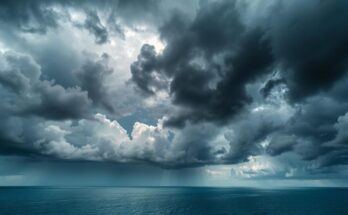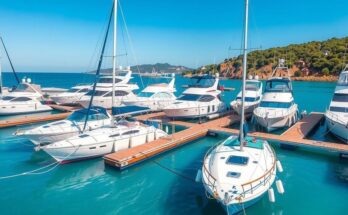On Tuesday, six tropical cyclones were active simultaneously in the southern hemisphere, particularly in the south-west Pacific. Severe Tropical Cyclone Alfred reached category-4 strength, while Rae and Seru affected areas around Fiji and the Solomon Islands. Severe Tropical Cyclone Bianca operated in the Indian Ocean, and two cyclones near Madagascar further illustrate the unusual conditions present within this meteorological event.
An extraordinary meteorological event occurred on Tuesday as six named tropical cyclones were concurrently active in the southern hemisphere. This phenomenon was particularly notable as several of these cyclones were situated in close proximity to one another. Among them, three cyclones emerged in the south-west Pacific.
Severe Tropical Cyclone Alfred originated in the Coral Sea, north-east of Australia, on 20 February. It escalated to the intensity of a category-4 hurricane, with maximum sustained winds reaching 105 mph (170 km/h) and gusts up to 140 mph. Although Alfred is forecasted to track south along the Queensland coast without making landfall, the Australian Bureau of Meteorology is closely monitoring its path due to concerns over strong winds and rough seas.
Two additional, shorter-lived storms were observed in the south-west Pacific: Tropical Cyclone Rae and Tropical Cyclone Seru. Rae was spawned north of Fiji on 22 February and moved south across the island, while Seru formed over the southern Solomon Islands on 24 February, traveling southward and passing east of Vanuatu and New Caledonia. Although Seru remained offshore, Rae caused substantial damage to Fijian islands due to heavy rainfall, gusts around 100 mph, and high waves.
In addition, Severe Tropical Cyclone Bianca developed in the Timor Sea, remaining active from 18 to 27 February. It traversed west across the south-east Indian Ocean before curving southward while avoiding landfall. This cyclone reached a peak intensity classified as a category-3 hurricane.
In the south-west Indian Ocean, two more cyclones were detected near Madagascar, both forming on Monday. The Intense Tropical Cyclone Garance, equivalent to a category-3 storm, formed to the north-east of Madagascar and is projected to impact the French island of Réunion significantly. Severe Tropical Storm Honde, classified as a category 1 storm, developed in the Mozambique Channel and is currently traveling south-east, skirted by the southern tip of Madagascar.
While the occurrence of multiple named storms is infrequent, it is not entirely unprecedented. It is noteworthy, however, that simultaneous storms within a single ocean basin are significantly rarer. The Pacific Ocean recorded six concurrent named storms once, in August 1974, while the Atlantic Ocean recorded five in September 1971.
In summary, the occurrence of six tropical cyclones simultaneously active in the southern hemisphere is a remarkable event, with significant impacts particularly observed in the south-west Pacific area. Severe Tropical Cyclone Alfred poses a potential threat along the Queensland coast, while Rae inflicted damage in Fiji. Overall, this situation underscores the complexity and unpredictability of tropical cyclone activity.
Original Source: www.theguardian.com




